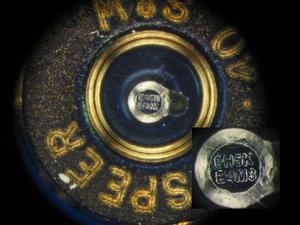Gun microstampingBattle over gun microstamping bill heats up in New York
New York is locked in a fierce political battle over proposed legislation that would require all guns sold and manufactured in the state to use “microstamping” technology; law enforcement officials favor the bill as it would provide investigators with valuable leads; Pro-gun advocates have staunchly opposed microstamping stating that the technology is flawed, threatens the rights of gun owners, and is expensive

Sample of microstamped cartridge // Source: shtfblog.com
New York State Legislature is locked in a fierce political battle over proposed legislation that would require all guns sold and manufactured in the state to use a new, patented “microstamping” technology.
Under the bill, which the New York State Assembly has already passed, every new gun sold in New York would be required to make a unique “stamp” on each spent bullet casing with information that could allow law enforcement to access a database of gun owners, to trace back to where the gun was sold and who purchased it.
The firing pin of each gun fitted with a microchip would, when the gun is fired, create a unique stamp on its shell casing. Most semi-automatic rifles and pistols eject spent casings, which can then be gathered from the crime scenes by law enforcement. By contrast, revolvers and single-shot guns do not automatically eject their spent cases.
Many law enforcement officials favor the bill as it could provide investigators with valuable leads after gun crimes. Supporters argue that with current ballistics technology, authorities only have a 2 percent chance of identifying the gun used in a crime, but claim that with microstamping, detectives have a 54 percent chance of successfully tracing the gun.
So far more than 100 mayors across the state of New York and more than eighty police departments have endorsed the legislation, but the bill has stalled in the New York State Senate.
Gun Rights advocates have staunchly opposed microstamping stating that the technology is deeply flawed, threatens the rights of gun owners, could lead clever criminals to scatter other people’s spent casings to falsley implicate innocent gunwoners, is pointless where neighboring jurisdictions do not rquire it, and is very expensive.
In a statement, Lawrence G. Keane, the senior vice president and general counsel of the National Shooting Sports Foundation, said, “Compelling the use of this unreliable patented sole-sourced technology will result in a ban on firearms for law-abiding consumers in the Empire State”
Keane went on to say, “Many manufacturers will choose to abandon the New York market rather than incur substantial costs associated with complying with microstamping legislation, which would include purchasing (at monopolistic prices) very expensive equipment and patented technology and completely redesigning their manufacturing processes, plant and equipment.”
In an opinion piece, Scott Diamond, who unsuccessfully ran against New York Assemblywoman Michelle Schimel in 2010, argued that microstamping is ineffective as “anyone who knows the anatomy of a gun can simply file down the firing pin wherein the micro-stamp is imprinted or replace it with an old pin that was not micro-stamped.”
He added “those who tamper with guns are not your average responsible gun owners, instead these are criminals who are also capable of filing down a firearms serial number imprinted on the side.”
Another major criticism of the bill is that microstamping would provide criminals with the ability to generate many false leads, diverting police investigations. Cunning criminals could esaily scatte spent shell casings, gathered at rifle and pistol ranges, at or near crimes scenes, falsley implicating completely innocent people. Every shell casing found would force law enforcement to investigate, at huge cost in time and manpower, every false lead.
Critics of microstamping argue that such tracing technology is pointless when forty-nine other states do not rquire it. “Any wannabe wiseguy or punk could get himself a gun from New Jersey, where they don’t have this microstamping thing. What exactly does that do to stop crime?” concluded one New York gun owner.
Meanwhile, the County Legislature of Niagara County, New York voted unanimously to oppose the microstamping bill expressing similar concerns that the technology can easily be tampered with.
Citing a 2006 University of California-Davis study, John Syracuse, a Niagara County legislator, said, “What we have here is this micro-stamping — I hesitate to use the word ‘technology’ — that has repeatedly failed in laboratory tests. And now the Assembly wants to require it.”
In the 2006 study, Davis researchers concluded, “At the current time it is not recommended that a mandate for implementation of this technology in all semiautomatic handguns in the state of California be made.”
Their conclusion was based on tests that found that the stamps left on spent casings were difficult to read, inconsistent, and the mechanism could be easily tampered with.
Democratic lawmakers are pushing to get the Republican controlled Senate to take up the bill, which has passed the Assembly three times.
Supporters of the bill argue that in 2009, 481 New Yorkers were killed by gun violence and microstamping might have given law enforcement officials an edge in fighting crime. The bill is opposed by gun owners groups and the New York State Conservative Party. Political observers give the bill little chance of passage through the State Senate.
